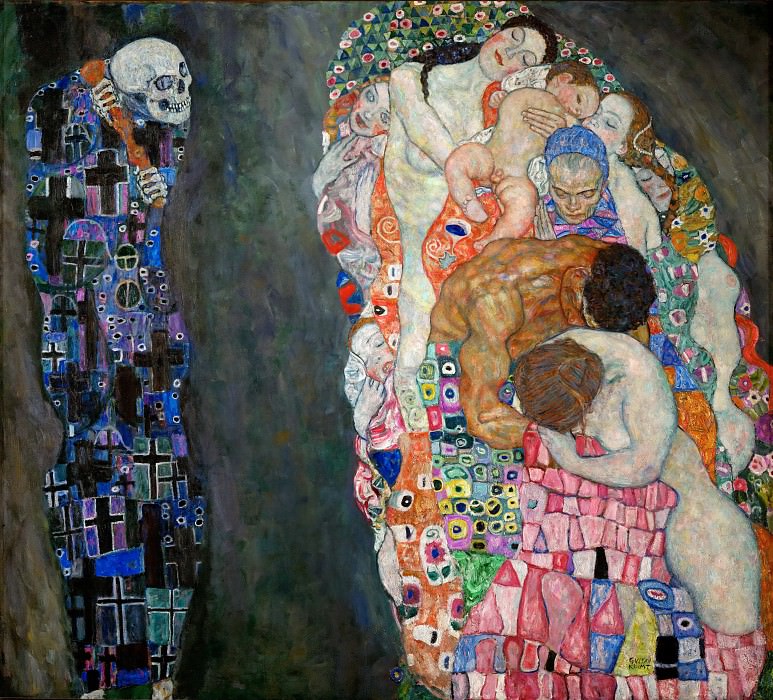Death and Life Gustav Klimt (1862-1918)
Gustav Klimt – Death and Life
Edit attribution
Download full size: 4560×4131 px (8,8 Mb)
Painter: Gustav Klimt
Location: Leopold Museum, Wien.
The famous Austrian painter is the progenitor of Art Nouveau in Austrian life. The main themes of his canvases are the beautiful female body. As such, the bulk of his work is imbued with explicit erotic subjects. At an early age Gustav discovered an attraction to painting. As a student, Gustav, along with his younger brother Ernst and his best friend Franz Macz created an art team, which quickly became famous and popular.
Description of Gustav Klimt’s painting Death and Life
The famous Austrian painter is the progenitor of Art Nouveau in Austrian life. The main themes of his canvases are the beautiful female body. As such, the bulk of his work is imbued with explicit erotic subjects.
At an early age Gustav discovered an attraction to painting. As a student, Gustav, along with his younger brother Ernst and his best friend Franz Macz created an art team, which quickly became famous and popular. The young men worked on sketches for a large-scale event timed to coincide with the silver wedding of Emperor Joseph of France and his bride, Empress Elisabeth. The style of the decoration of the celebration was reminiscent of Rubens’ paintings and the direction of the Venetian school.
Upon completion of their studies in Vienna, they opened their own workshop, and with this event their fame spread lightning-fast. And in 1885, the young talents were commissioned to paint the Empress’s favorite vacation spot, the Villa Hermes.
Later, Klimt was considered the most extraordinary artist of Austria. In his paintings intertwined questions of life, love, old age and death. The individuality of his work lies in the technique of conveying objects and elements that are filled with vivid color schemes of colors with a combination of golden colors. The artist uses exclusively pure colors and outlines the figures with a soft, rounded outline.
Death and Life reflects one of the leading themes of Klimt’s work. It depicts the dance of death, however, it seems that people do not yet foresee the impending danger. Here he used enamel, semi-precious stones and delightful marble mosaics and gold plating. This painting was the last large-scale project in the great artist’s life. All subsequent works were filled with wonderful and happy moments of life.
Кому понравилось
Пожалуйста, подождите
На эту операцию может потребоваться несколько секунд.
Информация появится в новом окне,
если открытие новых окон не запрещено в настройках вашего браузера.
You need to login
Для работы с коллекциями – пожалуйста, войдите в аккаунт (open in new window).




















COMMENTS: 3 Ответы
очарована околдована
Совершенно! Ничего лишнего.
Сразу угадываются образы, даже если не знать названия
You cannot comment Why?
The painting Death and Life by Gustav Klimt presents a stark contrast between two sides, symbolizing the ongoing struggle and interplay of these fundamental forces.
On the left, Death is depicted as a skeletal figure adorned in a patterned robe. The robe is a mosaic of crosses and dark, jewel-toned rectangles in shades of blue, purple, and black, some of which suggest a cross shape. Deaths posture is slightly hunched, and its bony hands grasp a wooden club, poised as if ready to strike. The background behind Death is dark and ominous, emphasizing its grim presence.
On the right, Life is represented by a vibrant and intimate cluster of nude human figures. This group is a dynamic tangle of bodies in various stages of life and connection. At the top, a woman cradles an infant, surrounded by other individuals. A baby is nestled in a womans arm, while an elder figure with blue head covering appears to be praying or in deep thought. At the center, a muscular man embraces a woman, who cowers with her head bowed. The figures are enveloped in a brightly colored, richly patterned fabric, filled with floral motifs and abstract shapes in reds, oranges, greens, yellows, and blues. This chaotic yet beautiful mass represents humanitys embrace of life, love, and connection.
Subtexts: